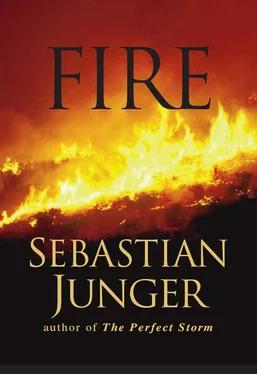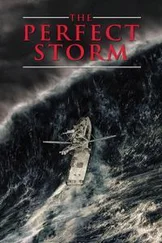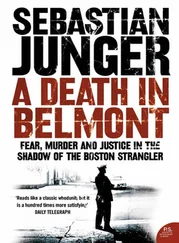Above him, the BLM and upper Prineville crews had abandoned hope of reaching H-1 and scrambled north toward H-2. When that route too was blocked, they turned and plunged over the ridge. Due south, one hundred feet below H-1, the eight smoke jumpers who had been ordered out by Don Mackey fifteen minutes earlier were crawling under their foil shelters to wait out the approaching fire storm. At Canyon Creek far below, a crew of fresh smoke jumpers who were preparing to hike in watched in horror as eight little silver squares appeared on the mountainside. Meanwhile, hidden from view by smoke, Mackey, the Prineville nine, and the three smoke jumpers were running a race only one of them, Hipke, would win.
In the end twelve of the dead were found along the lower fire line. Prineville hotshot Scott Blecha had also run past Thrash but lost his race a hundred feet from the ridgeline. The rest were in two main groups below a tree— the tree, as it came to be known, where Haugh had started his run—a few clumped so close together that their bodies were actually touching. Only smoke jumpers Thrash and Roger Roth had deployed their shelters, but the blistering heat disintegrated the foil. Kathi Beck died alongside Thrash, partly under his shelter. It seemed that in his last agony, Thrash may have tried to pull her in. In addition, Richard Tyler and Robert Browning, two fire fighters deployed earlier to direct helicopter operations, perished just north of H-2, only a few hundred feet from a rocky area that might have saved them.
The Prineville nine’s dash for safety ended after three hundred feet. They were caught just three or four seconds before Haugh himself cleared the ridgetop, and he could hear their screams over his radio. Reconstructing the details of the victims’ agonized last seconds would occupy many hours of professional counseling for the survivors.
Dying in a fire is often less a process of burning than of asphyxiation. Their suffering was probably intense but short-lived. Pathologists looked for carbon in their lungs and upper airways and found none, which meant the victims weren’t breathing when the fire passed over them. Their lungs were filled with fluid, their throats were closed in laryngeal spasms—responses to superheated air—and their blood contained toxic levels of carbon monoxide. This gas, given off during incomplete combustion, displaces oxygen in the blood and kills very quickly.
“They died after a few breaths at most,” said Rob Kurtzman, a pathologist at the Grand Junction Community Hospital, “probably in less than thirty seconds. All the body changes—the charring, the muscle contractions, the bone fractures—happened after they were dead.”
About four-thirty Haugh, Erickson, and Hipke staggered onto Interstate 70. Just an hour before, they had enjoyed a well-earned break on the mountain; now fourteen people were dead. But all they knew at that point was that Blanco, the incident commander, was calling out names on the radio and a lot of people weren’t answering.
Haugh and Erickson laid Hipke in the shade of a police cruiser and doused him with water to lower his body temperature and prevent him from going into shock. Blanco climbed back up toward the fire to look for more survivors but found none. The eight smoke jumpers who’d deployed their shelters below H-1 emerged, shaken but unhurt. They were saved not by their shelters but by having deployed them on previously burned ground. The fire was still pumping at this point, and Glenwood Springs was now in danger. Flames were racing eastward along the upper ridges, and the BLM command post at nearby Canyon Creek had begun ordering residents to evacuate.
Haugh’s BLM crew had survived. The other Prineville Hotshots—the upper placements—made it out as well. They had snaked their way down the east side of the ridge through a hellish maze of spot fires and exploding trees. Two of them had tried to deploy their shelters but were dragged onward by friends.
Word quickly filtered back to BLM officials in Grand Junction that something terrible had happened on Storm King. Mike Mottice, the agency’s area manager, had driven past the blowup and arrived at his Glenwood Springs office around 5:00 P.M. Minutes later crews began arriving from the mountain, and Mottice realized for the first time that there were people unaccounted for. “I hoped that the fire shelters would save them,” he said. “But that evening some smoke jumpers confirmed that there were deaths.”
The surviving Prineville crew members suspected that some had died, but they didn’t know for sure until later that night. They were shuttled first to the Glenwood Springs office, then to Two Rivers Park at the center of town. An open-air concert was in progress, and they sat in their fire clothes while the mountains burned and local youths took in the music. Finally, around nine, a social worker named Carol Kramer arrived with Prineville crew boss Brian Scholz. Kramer was to take the crew back to the Ramada Inn. A conference room was quickly prepared where she could tell them privately that nine of their friends had died.
“When we reached the hotel, they started falling apart,” said Kramer. “At that point, they knew. They were begging us to tell them, to just get it over with. I told them it was bad, that twelve were dead and five were missing.”
The survivors’ reaction was quick and violent. Some sobbed; others pounded tables. One fire fighter fled the room and threw up. Two crew members quickly left, followed by Scholz, who wanted to keep an eye on them. As a crew boss Scholz considered himself still on duty, and he refused to lose control in front of his men. Gradually a list of survivors was compiled.
“For a while there was a lot of being out of control,” said Kramer. “Then for a few hours the sobbing was only intermittent; finally, there were a lot of thousand-yard stares. They’d just sit together silently. The next morning they ate a little food. It was a small thing, but that’s what you look for.”
Some of the most traumatized accepted individual counseling. One thing they needed was to describe the things they had experienced. One man relayed in excruciating detail the sounds of screams and shouts he had heard as he escaped over the hill. Within thirty-six hours, the eleven Prineville survivors were flown home to Oregon—in part to reunite them with their families, in part to protect them from being hounded by the national press corps. The Ramada Inn had become a shark pool of competing journalists, and the last thing survivors needed was TV cameras panning their faces for tears and anguish.
On Monday, July 11, a memorial service was held in Glenwood Springs. While Storm King Mountain smoldered in the background, helicopters flew in formation overhead and people wept to the strains of “Amazing Grace.” President Clinton called Governor Roy Romer from Air Force One, and flags on government buildings throughout the country were at half-mast. At dawn the next day, the bodies of the Prineville nine were driven to Walker Field in Grand Junction and then flown home in a Forest Service DC-3. The remains were delivered to four different airfields in Oregon while honor guards played taps and next of kin received the caskets on the tarmac.
Before the embers were even cold on Storm King Mountain, a ten-member investigation team was convened and given forty-five days to examine the site and deliver its findings. The team was composed of former fire fighters and experts in fire behavior, meteorology, and safety equipment. The question of specific blame, however, was not supposed to arise; it was to be a strictly analytical study of what had happened and when.
The preferred view among most federal fire personnel and even most South Canyon survivors was that the West was apocalyptically dry and huge fires were bound to happen. On such fires, people sometimes die; indeed, there are a few fatalities every year. “I would go out on a fire line again with any person who was there,” insisted the BLM’s Mike Hayes. “We were doing the best we could with the resources we had. I mean, there were fifty fires in our district at the time.”
Читать дальше












